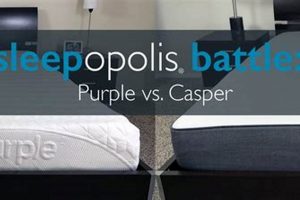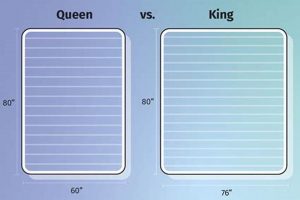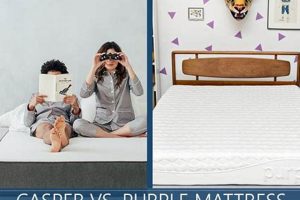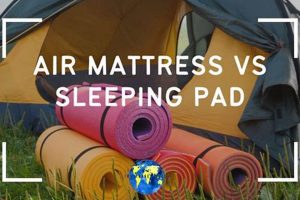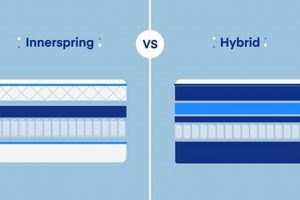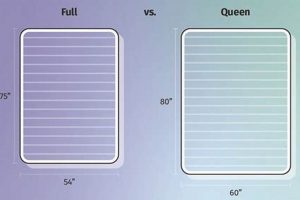A support structure designed to elevate and provide a stable surface for a mattress can take different forms. Two common types are the traditional coil-based unit and the more modern solid or slatted base. One typically contains springs and provides give, while the other offers a firmer, more rigid platform. Choosing the appropriate type depends on the mattress type and the desired level of support and comfort.
The choice of support structure impacts the lifespan and warranty of the overlying mattress. Proper support prevents sagging and uneven wear, potentially prolonging the mattress’s useful life. Furthermore, the type of support can influence the overall sleep experience by affecting the feel and responsiveness of the mattress. Historically, one option was the standard choice, but contemporary mattress designs and evolving preferences have led to a greater variety of options.
The following discussion will delve into the specific characteristics, advantages, and disadvantages of these two primary types of mattress supports, examining their construction, suitability for various mattress types, and overall impact on sleep quality and mattress longevity. This analysis will provide a clearer understanding of the differences and help inform the selection of the optimal support system.
Selection Guidance
Choosing the appropriate mattress support is critical for optimal sleep quality and extending the life of the mattress. The following tips offer guidance on making an informed decision based on individual needs and mattress compatibility.
Tip 1: Assess Mattress Compatibility: Prior to selection, determine the mattress manufacturer’s recommendations. Certain mattresses, particularly memory foam and latex models, perform best on solid or slatted platforms. Using a coil-based unit may void the warranty or diminish the mattress’s intended performance.
Tip 2: Evaluate Support Needs: Consider individual weight and preferred sleep position. Heavier individuals may benefit from the firmer support provided by a solid foundation, while those who prefer a softer feel may find a coil-based unit more suitable.
Tip 3: Measure Bed Frame Dimensions: Ensure the chosen support structure fits properly within the existing bed frame. Incompatible dimensions can lead to instability and potential damage to both the mattress and the frame.
Tip 4: Consider Noise Reduction: Some coil-based units can become noisy over time. If noise sensitivity is a concern, a solid or slatted platform might be a better option. Regular maintenance, such as tightening any loose components, can help mitigate noise issues in coil-based systems.
Tip 5: Review Warranty Implications: Confirm that the selected support system meets the warranty requirements of the mattress. Using an incompatible foundation may invalidate the warranty, leaving the consumer responsible for any premature wear or damage.
Tip 6: Evaluate Height Preferences: Account for the height of the support system when considering the overall bed height. A taller support system may require a lower-profile mattress, and vice versa, to achieve the desired bed height.
Proper selection contributes to enhanced sleep quality, improved mattress longevity, and the fulfillment of warranty obligations. Careful consideration of these factors will facilitate a more informed and beneficial purchase.
The subsequent sections will provide a detailed comparison of specific models and brands, further assisting in the selection process.
1. Support structure
The support structure is the fundamental component distinguishing a mattress foundation from a box spring. A mattress foundation typically features a solid or slatted platform designed to provide firm, even support across the entire mattress surface. This design directly affects mattress performance, particularly for foam and hybrid models, where consistent support is crucial for preventing sagging and maintaining optimal comfort. A box spring, conversely, traditionally incorporates a coil system intended to provide additional shock absorption and flex.
The choice of support structure has a direct causal effect on mattress longevity and warranty adherence. For example, placing a memory foam mattress on a traditional box spring may lead to uneven wear and potential structural damage to the mattress, potentially voiding the manufacturer’s warranty. The importance of the support structure is highlighted by its direct influence on the overall sleep experience; a properly chosen support system promotes correct spinal alignment and minimizes motion transfer. As an example, a platform foundation paired with a latex mattress offers a firm, responsive feel, while a box spring might cause excessive sinking, particularly around high-pressure areas.
In summary, the support structure dictates the functional characteristics and suitability of a mattress foundation or box spring. Understanding these structural differences is paramount for maximizing mattress performance, ensuring warranty compliance, and ultimately, optimizing sleep quality. Challenges arise when consumers neglect to consider mattress type compatibility, leading to premature mattress degradation and a compromised sleep experience. Therefore, informed decision-making regarding the support structure is essential for realizing the full potential of a mattress investment.
2. Mattress compatibility
Mattress compatibility is a critical consideration when evaluating the suitability of a foundation versus a box spring. The type of mattress, its construction materials, and the manufacturer’s recommendations directly influence which support system will provide optimal performance and longevity.
- Innerspring Mattress Considerations
Traditional innerspring mattresses, characterized by their coil-based support core, were historically designed for use with box springs. The box spring’s coil system provided supplemental support and shock absorption, extending the mattress’s lifespan and enhancing comfort. However, modern innerspring mattresses may also perform well on solid foundations, depending on the coil gauge and layering materials. Misalignment of support systems can result in premature wear.
- Memory Foam and Latex Mattress Requirements
Memory foam and latex mattresses generally require a firm, flat surface to prevent sagging and ensure proper support. Foundations, with their solid or closely-spaced slat designs, are often the preferred choice. Using a box spring with these mattress types can lead to uneven weight distribution and reduced support, potentially voiding the mattress warranty. For instance, a high-density memory foam mattress placed on a traditional box spring might develop indentations over time.
- Hybrid Mattress Specifications
Hybrid mattresses, combining innerspring and foam layers, present a unique compatibility challenge. The ideal support system depends on the dominant characteristics of the mattress. If the mattress has a substantial innerspring component, a box spring might be suitable. However, if the foam layers are more prominent, a solid foundation is generally recommended. Failure to match appropriately could negate some of the benefits intended by the hybrid design.
- Warranty Compliance and Support Requirements
Mattress manufacturers often specify the type of support system required to maintain warranty validity. Deviating from these recommendations can result in warranty denial if issues arise. Furthermore, the correct support system ensures the mattress performs as intended, providing the advertised level of comfort and support. Selecting a compatible support system is not merely a matter of preference; it is a practical necessity for safeguarding the mattress investment.
In summary, mattress compatibility is a crucial determinant in the choice between a foundation and a box spring. Failing to consider the specific requirements of the mattress can lead to compromised performance, reduced lifespan, and potential warranty issues. The material composition and design of the mattress must align with the support system to achieve optimal results.
3. Height profile
The height profile of a mattress support system significantly influences both the aesthetic and functional aspects of a bed setup. The total height of the bed, combining the support system, mattress, and any bedding, affects ease of access, visual proportions within the room, and perceived comfort. A box spring typically adds considerably more height than a standard foundation, thus impacting the overall bed elevation. The choice between a box spring and a foundation, therefore, directly affects the final height, requiring consideration of individual preferences and physical needs. For example, individuals with mobility limitations may find a lower bed height more accessible, making a foundation a more suitable choice. Conversely, others may prefer a taller bed for aesthetic reasons or ease of getting in and out.
The height profile also interacts with the mattress type. A thicker mattress might pair well with a lower-profile foundation to maintain a balanced overall height. Conversely, a thinner mattress might require a box spring or a higher foundation to achieve a comfortable height. The selection of bed frames further complicates this interaction. Bed frames are designed with specific height requirements, and using an incompatible support system can result in either a too-low or too-high mattress position within the frame. For example, a platform bed frame inherently dictates a lower height profile, necessitating the use of a low-profile foundation or eliminating the need for a separate support system altogether. Failing to consider these factors can lead to discomfort or aesthetic imbalances.
In summary, the height profile is an essential factor in the mattress support selection process. A box spring’s added height versus the typically lower profile of a foundation impacts accessibility, aesthetics, and compatibility with mattresses and bed frames. Careful consideration of these elements ensures a comfortable and visually harmonious sleep environment. The challenges lie in balancing personal preferences with practical needs and ensuring compatibility across all components of the bed setup, highlighting the importance of informed decision-making.
4. Durability expectations
Durability expectations constitute a primary factor in distinguishing a mattress foundation from a box spring. A mattress foundation, typically constructed with a solid or slatted platform, exhibits a longer lifespan due to its simpler design and robust materials. This inherent durability translates to a more consistent support system over time, minimizing the risk of sagging or structural failure. A box spring, conversely, incorporating coils and fabric, is inherently more susceptible to wear and tear. Repeated compression can lead to coil fatigue, resulting in uneven support and a reduction in overall comfort. For instance, a foundation constructed from kiln-dried hardwood is expected to maintain its structural integrity for a decade or more, whereas a box spring may require replacement within a shorter timeframe due to coil degradation.
The correlation between durability and mattress performance is significant. A foundation’s sustained support ensures the mattress retains its intended shape and comfort characteristics. Conversely, a box spring’s declining support can negatively impact the mattress, leading to premature wear and diminished sleep quality. For example, a memory foam mattress placed on a failing box spring is likely to develop impressions and lose its conforming properties. The economic implications of durability expectations are also noteworthy. While a foundation may represent a higher initial investment, its extended lifespan often results in a lower total cost of ownership compared to the recurring expense of replacing a box spring. The cause-and-effect relationship is evident: higher durability expectations lead to a preference for foundations, while lower expectations or budget constraints may favor the less durable but often more affordable box spring.
In conclusion, durability expectations play a pivotal role in the selection between a mattress foundation and a box spring. The simpler construction and more robust materials of a foundation offer a longer lifespan and sustained support, aligning with higher durability expectations. Conversely, the coil-based design of a box spring makes it more susceptible to wear, potentially requiring more frequent replacement. Understanding these distinctions is crucial for making an informed decision that aligns with individual needs and long-term cost considerations, ensuring optimal mattress performance and a satisfactory sleep experience. The primary challenge lies in accurately assessing long-term durability needs versus immediate budgetary constraints, impacting the ultimate selection.
5. Noise generation
The potential for noise generation represents a significant, though often overlooked, aspect when differentiating between a mattress foundation and a box spring. The internal construction of each support system directly influences its propensity to produce sound during use. A box spring, with its interconnected network of coils, is inherently more susceptible to generating noise as the coils compress and shift under weight. This noise can manifest as squeaks, creaks, or groans, particularly as the box spring ages and the coils lose their original tension or become misaligned. Conversely, a solid mattress foundation, lacking internal moving parts, generally produces minimal noise, providing a quieter sleep environment. For example, individuals sensitive to sound disturbances may find the consistent creaking of a worn box spring disruptive, while a platform foundation offers a more silent and stable alternative. Noise generation’s importance arises from its direct effect on sleep quality and overall comfort, particularly for light sleepers or those sharing a bed.
The type of mattress paired with the support system can exacerbate or mitigate noise-related issues. A heavier mattress places greater stress on a box spring’s coils, increasing the likelihood of noise production. Conversely, a lighter mattress may exert less pressure, reducing the potential for sound. Similarly, the bed frame itself can contribute to noise if it is not properly assembled or if it lacks adequate support for the mattress and support system. For example, a loose bed frame can amplify vibrations and squeaks originating from a box spring. Regular maintenance, such as tightening bolts and lubricating joints, can help minimize noise from both the support system and the bed frame. Furthermore, certain box spring designs incorporate noise-dampening materials to reduce sound transmission. These designs often utilize fabric or foam padding to minimize friction between the coils and the frame.
In summary, noise generation is a relevant factor when choosing between a mattress foundation and a box spring, primarily due to the inherent differences in their construction. The coil-based design of a box spring makes it more prone to producing noise, potentially disrupting sleep. A solid foundation, offering a quieter and more stable alternative, often appeals to those sensitive to sound. While mattress type and bed frame construction can influence noise levels, the fundamental distinction in noise generation remains a key consideration in the decision-making process. The challenge lies in predicting the long-term noise performance of a box spring and mitigating potential issues through proper maintenance and compatible component selection, ultimately impacting the sleep environment.
Frequently Asked Questions
The following section addresses common inquiries regarding mattress foundations and box springs, providing concise, factual responses to aid in informed decision-making.
Question 1: Is one support system universally superior to the other?
No. The optimal choice depends on the type of mattress, individual preferences, and specific needs. Factors such as mattress construction, desired firmness, and potential noise generation must be considered.
Question 2: Will using the incorrect support system void a mattress warranty?
Potentially. Many mattress manufacturers specify the required support system to maintain warranty validity. Deviation from these recommendations may result in warranty denial if related issues arise.
Question 3: Are box springs outdated?
Box springs are not inherently outdated, but their suitability has diminished with the rise of memory foam and latex mattresses. Their compatibility is primarily limited to traditional innerspring mattresses.
Question 4: Do foundations offer better support than box springs?
Foundations typically provide firmer, more uniform support, particularly for foam-based mattresses. Box springs offer more give, which may be preferred for certain innerspring models, but can lead to sagging with other mattress types.
Question 5: Can the support system impact sleep quality?
Yes. The support system directly influences spinal alignment, pressure distribution, and motion isolation, all of which contribute to sleep quality. An inappropriate support system can lead to discomfort and restless sleep.
Question 6: How does the height profile of each system differ?
Box springs typically add more height than foundations. This difference impacts overall bed height and may influence ease of access and aesthetic considerations.
In summary, selecting the appropriate mattress support system requires careful consideration of mattress type, personal preferences, and warranty requirements. Understanding the distinctions between foundations and box springs facilitates informed decision-making and optimizes sleep quality.
The subsequent section will offer a comparative analysis of specific models, brand recommendations, and considerations for budget-conscious consumers, further aiding in the selection process.
Mattress Foundation vs. Box Spring
This exploration has detailed the critical differences between a mattress foundation and a box spring, elucidating their respective structural characteristics, compatibility with various mattress types, and implications for overall sleep quality. The analysis has underscored the importance of considering factors such as support, durability, noise generation, and warranty requirements when selecting the appropriate support system. Modern mattress designs often necessitate the consistent, unyielding support provided by a foundation, while traditional innerspring mattresses may exhibit compatibility with a box spring. However, the potential for coil fatigue and reduced lifespan in box springs warrants careful evaluation.
The decision to utilize a mattress foundation vs. box spring should not be approached lightly. It represents a considered investment in sleep health and mattress longevity. Consumers are encouraged to meticulously assess their individual needs and mattress specifications to ensure optimal performance and enduring comfort. Proper selection mitigates the risk of premature mattress degradation and fosters a more restful and restorative sleep experience.


